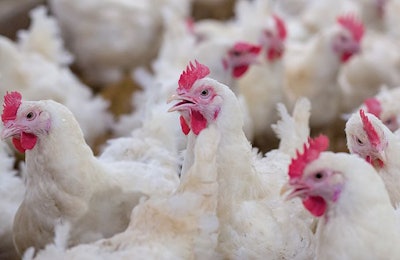
Feathering of broilers, broiler breeders and leghorn hens has been a topic of commercial interest for decades. In the past few years, broiler breeder feathering has become an issue in mid-production with poor feathering appearing by 45 weeks of age -- 8 to 10 weeks ahead of when some feather damage was traditionally noticed. Prior to that, feathers appear dry and brittle, with noticeable breakage. Feathering problems may be related to poor feather quality, feather pecking or a combination of the two factors.
Poor feathering has been associated with reduced mating late in lay (as hens’ bare skin is scratched by the males) and less cold tolerance due to reduced feather cover. If feather cover is poor in the winter months, and feed allotments are not increased, reduced performance has been occasionally reported.
Protein benefits pullet feathering
Due to nearly constant molting and replacement of feathers during the pullet phase of production, nutrition must be optimal to keep feather quality progressing normally.
Good body weight control throughout is key to this concept. If birds get ahead of the curve during the growing period and growth must be slowed down using slower increases in feed allotment, future feather quality may be compromised. Again, careful attention to following the growth curve during the pullet phase and as birds are brought into production can help to reduce feathering problems later in the laying cycle. One study, conducted at Auburn University, fed varying protein levels to breeder pullets until six weeks of age, which showed noticeable differences in feathering by 10 weeks of age.
Pullet starter feeds with approximately 19 to 20 percent crude protein have traditionally been used for the first four weeks of rearing but extending the duration of starter feed to six weeks of age may be advisable to increase early protein intake and enhance early feathering. Although breeder pullets complete three molts by peak production, early nutrition enhancing feather quality may carry through into the breeder house.
Nutritional approaches
Feathers are mostly protein, and poultry companies have made several changes to either increase the amino acids that hens need to maximize feathering or increase trace minerals or vitamins that are involved in the pathways that create feather proteins in the bird.
- Amino acids
Although methionine and cysteine are important components of feathers, methionine is the only one that we can easily add to breeder feeds. Broiler companies have increased the amount of methionine included in their breeder feeds by increasing the total sulfur amino acid (TSAA)-to-lysine ratio in the pullet and breeder phase. In many cases, the digestible TSAA-to-digestible lysine ratio will be approximately 100 to 105 percent to encourage feathering. While methionine and cysteine receive much of the attention in regards to feathering, other amino acids shouldn’t be overlooked and can play important roles in feathering. Branched-chain amino acids (valine, isoleucine and leucine) and arginine show relatively high levels in feather protein. Some nutritionists set minimum levels for each of these amino acids, while some set minimum protein levels for further insurance.
Enhancing levels of B vitamins (pyridoxine, biotin) may facilitate feather growth, and some operations have increased vitamin inclusion across the board. Other poultry company nutritionists have increased the amount of folic acid added to feed because folic acid is involved in the biochemical pathway which transforms methionine into cysteine. Cystine is particularly important in feathers, but is hard to increase in feed through reformulating normally available ingredients. For this reason, all pathways that help increase the use of feed methionine to improve feathering are being optimized. Also, lack of fiber may contribute to pecking and feather eating if feed fiber does not provide enough roughage for birds.
- Minerals
Mineral nutrition can also help to improve feathering, and many poultry companies have included increased trace mineral levels. Others have opted for more digestible sources of zinc, copper and selenium as organic sources of these minerals have been shown to have enhanced absorption. Feathers from stressed pullets and breeders often show stress lines (weak strips running horizontally across the feathers) from temporary zinc deficiency due to stress-induced increased need for zinc in the feed. These stress lines are weaker than the remainder of the feathers and may lead to breakage at that point. Research with organic zinc sources have shown improved regrowth of feathers in growing birds with enhanced supplementation. Improvements in total feather weights of broilers were also seen with organic selenium supplementation.
- Mycotoxins
Finally, feed mycotoxins may play a role in poor feather growth during the pullet phase. Several of the scirpentriol mycotoxins elaborated by Fusarium molds caused frayed feathers with poor webbing in growing birds. Affected feathers may not stand up to the rigors of the flock throughout the breeding cycle. Earlier broiler studies showed poor feathering in broilers fed T-2 toxins. T-2 problems have been associated with helicopter disease (abnormal feathering) in the field.
Taken in total, nutritionists from poultry companies have altered several nutrients in the feed to help overcome breeder feathering problems. Nutrition in the pullet and breeder house may contribute to improving feathering issues in mid- to late lay. Company nutritionists have made a few changes to keep feathering optimal, and feeding programs in the field can complement these changes by careful following of body weight curves as the birds age.
References available upon request.
Editor’s note: Research was conducted by Joe Hess and Wallace Berry with Auburn University; Benton Hudson, Aviagen; and Jeanna Wilson, University of Georgia.

















